Ceramic Gallery in Hall of Martial Valor (Wuyingdian)
The Ceramic Gallery in the Forbidden City stands as China's largest and most comprehensive ceramic exhibition, displaying Chinese ceramics of 10 thousand years and the ones for special use in imperial life.
Cross the Gate of Unified Harmony (Xiehemen) on the west side of the Meridian Gate, and visitors will see the Hall of Martial Valor (Wuyingdian), where their China's ceramic journey begins.
Main Exhibition Area: A Visible Chinese Ceramic History
The main hall, rear hall, and connecting corridor form the core of the Gallery, showcasing the development of Chinese ceramics in chronological order through 17 themes.
Theme 1: Exploring the Roots – Neolithic Period (8000 BC – 2000 BC)
 |
| Black Pottery Vase |
 |
| White Pottery Bird Vessel |
1. Black Pottery Tripod Goblet (2600 BC – 2000 BC)
Experience the elegance of ultra-thin black pottery, just 0.3-1-millimeter-thick, renowned for its deep jet-black hue and shell-like delicacy.
2. White Pottery Bird Vessel (6000 BC – 4200 BC)
Admire this rare white clay vessel with smooth, intricate lines, shaped like a three-leg noble bird, hinting at bird totem worship.
Theme 2: Dawn of Porcelain – Xia, Shang, Zhou, Qin, and Han Dynasties (2100 BC – 220 AD)
This exhibition, showcasing over 40 standout pieces, takes you on the evolution from the plain potteries to the more exquisite porcelains.
 |
| Proto-Porcelain |
 |
| Pottery Imitating Bronze Ware |
1. Birth of Proto-Porcelain
Meet the world's oldest proto-porcelain, crafted with clay and glazed using plant ash, including jars with double handles and phoenix motifs.
2. White Pottery Imitating Bronze Wares
The remarkable white jade-like pottery from 1600-1000 BC, while continuing the robust and majestic feel of bronze ware in shape, distinguishes itself with its delicate clay texture and pristine white color, offering a refreshing visual contrast.
Theme 3: Evolution of Celadon Porcelain - Three Kingdoms, Western & Eastern Jin, and Northern & Southern Dynasties (220 – 589 AD)
This section reveals the evolution of the celadon porcelain, the decorative shifts influenced by Buddhist culture, and breakthroughs like the emergence of white porcelain.
 |
| Celadon Buddhist Censer |
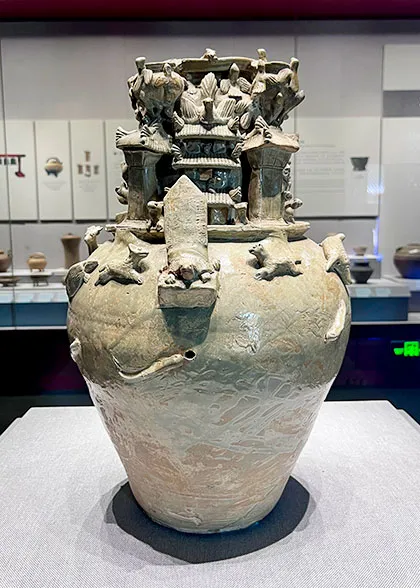 | 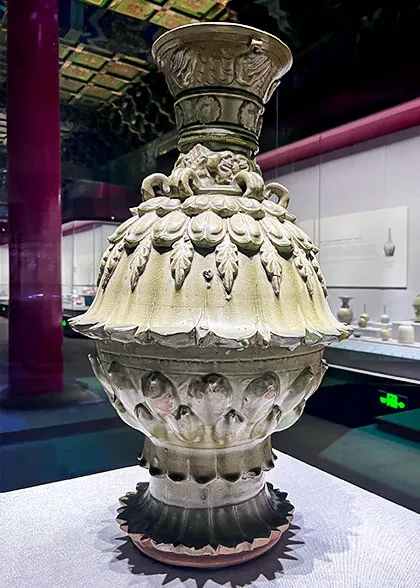 |  |
| Celadon Granary Jar | Celadon Lotus Vase | Celadon Figure-and-Animal Jar |
1. Celadon Granary Jar
Carved with scenes of birds vying for food, harvest celebrations, and livestock pens brimming with animals, it tells a story of the abundance of manor houses in southern Yangtze River regions 1,700 years ago.
2. Celadon Lotus Vase
A 67-cm (26-inch) Buddhist ritual vase, adorned with 11 layers of relief lotus petals and celestial beings, this piece is the most intact of the two held in the Forbidden City.
Theme 4: Southern Celadon & Northern White - Sui, Tang, and Five Dynasties (581 – 960 AD)
This exhibition highlights the craftsmanship of the “rain-washed sky blue” celadon from the south Yue Kiln and the “silver-like and snow-white” porcelain from the north Xing Kiln . It also features exotic pieces inspired by the Silk Road, including Persian-style leather-covered vases and Indian Buddhist water jars.
 |
| Celadon Lidded Jar, Five Dynasties (907 - 960 AD) |
 |
| Color Glaze Phoenix Porcelain |
1. Celadon-Glazed Pot with Phoenix Head and Dragon Handle
The belly of the pot is embossed with images of westerners engaged in musical performances and dances, reflecting a cultural exchange between ancient China and the West.
2. Yue Kiln Celadon-Glazed Octagonal Vase
With its jade-like glaze and unique octagonal shape, this vase showcases the Tang Dynasty's geometric aesthetics.
3. Lushan Kiln Flowered Ceramic Waist Drum
A remarkable piece at 60 cm (24 inches) long, this waist drum boasts soft lines, bold decorations, and a striking contrast between dark and bright glazes, resembling clouds in the sky or ink in water.
Theme 5: Legacy of Famous Kilns – Liao, Song, Western Xia, and Jin Dynasties (907 – 1279 AD)
The exhibition showcases the golden age of Chinese porcelain, when various kilns flourished, producing both high-end porcelain for imperial use and everyday utensils for common folk.
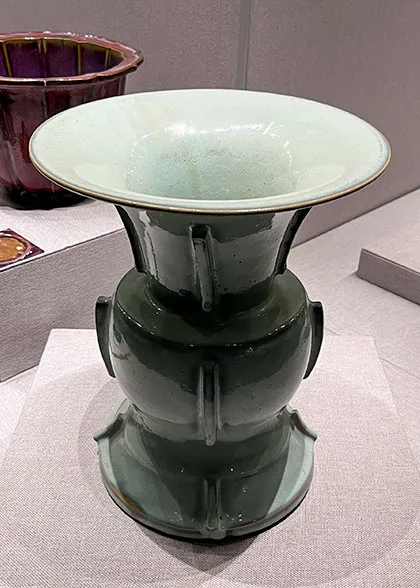 |  |  |
| Jun Kiln Moon-white Vessel | White Tiger Pattern Vase | Celadon Glaze Vase with Ice Cracks |
1. Ru Kiln Celadon-Glazed Three-Legged Wine Vessel
A unique and intact example, its luminous celadon glaze is adorned with natural “ice cracks”, transforming imperfections into a distinctive beauty.
2. Ding Kiln White-Glazed Child-Shaped Pillow
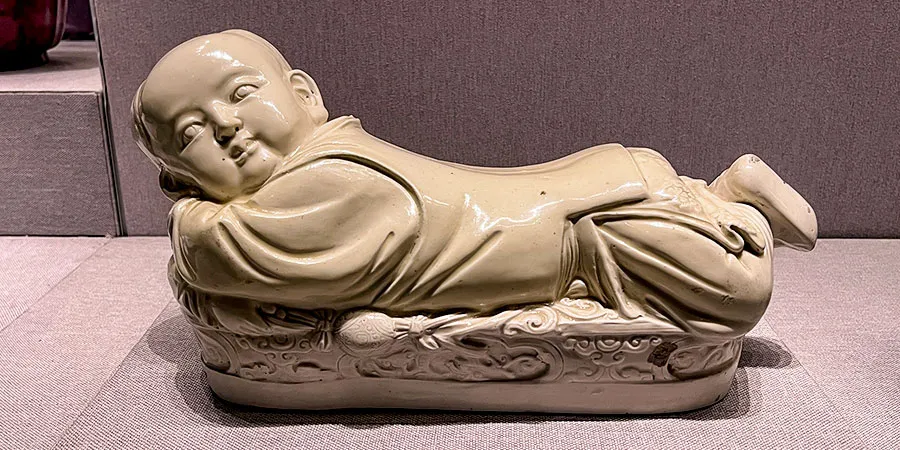 |
| Ding Kiln White-Glazed Child-Shaped Pillow |
A delightful masterpiece, this pillow captures the innocence and liveliness of a child, with delicate features and expressive eyes.
3. Jun Kiln Rose-Purple Glazed Begonia Flowerpot
This flowerpot showcases the Jun Kiln's color-change technique by the magical rose-purple and celadon glazes.
Theme 6: The Porcelain Capital Jingdezhen – Yuan Dynasty (1271 – 1368 AD)
 |
| Blue, White & Red Glazed Porcelain |
Witness Jingdezhen's transformation from local kiln to global ceramic hub. Key innovations this period include underglaze blue and white, underglaze red, and eggshell glaze.
Jingdezhen Kiln Underglaze Blue and Red Carved Cover Jar
This jar showcases striking contrast between underglaze blue and red, with intricate floral and rocky scenes, exuding luxury and nobility.
Theme 7: Prosperity & Flourishing – Jingdezhen Kiln and Local Kilns of the Ming Dynasty (1368 – 1644 AD)
This exhibition centers on Jingdezhen, presenting the peak achievements of Ming Dynasty ceramic production. Explore two distinct sections: imperial porcelain from Jingdezhen and folk treasures from renowned kilns.
 |
| Imperial Porcelain from Jingdezhen, Ming Dynasty |
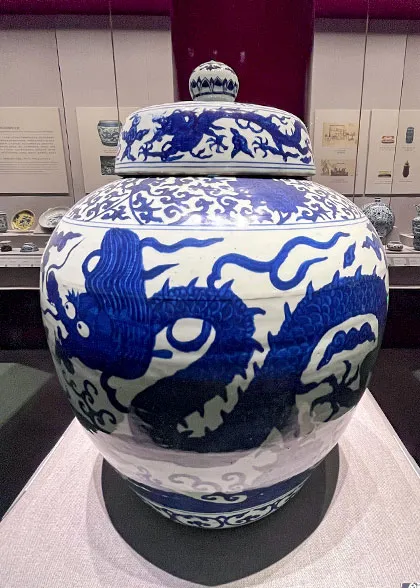 | 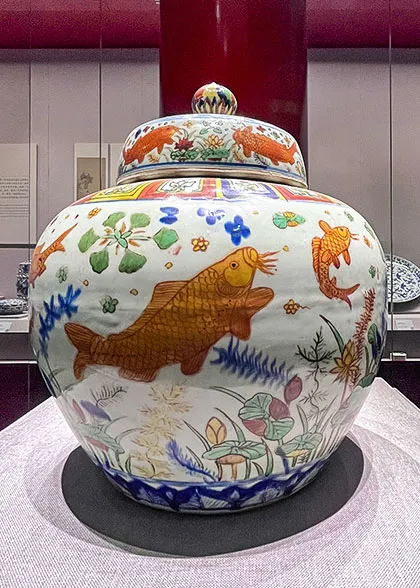 | 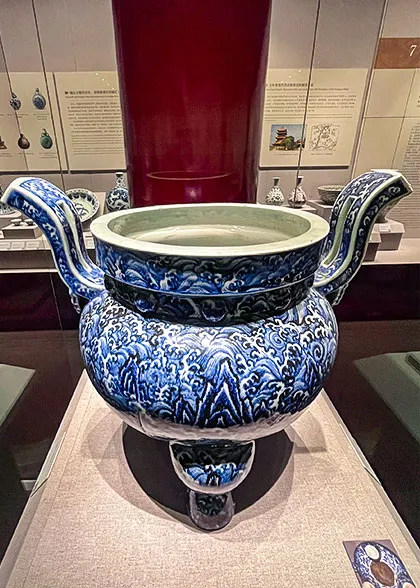 |
| Dragon Pattern Vase | Color-glazed Fish Pattern Vase | Wave Pattern Tripod Stove |
1. Underglaze-Red Vase with Melon-Shape Sections
This 2.6-meter-tall (8.5-foot) vase, designed like a melon with 12 sections, symbolizes monthly harvests. Its underglaze-red flowers show a rare gradient effect, a beauty modern technology struggles to replicate.
2. Polychrome Jar with Sea Monsters
This jar depicts roaring elephant-headed, lion-bodied sea monsters leap into the air amidst splashing waves, showcasing the exceptional painting skills of Jingdezhen imperial porcelain craftsmen.
 |
| Late Ming and Early Qing Porcelain |
Theme 8: Jingdezhen Porcelain Elegance from Late Ming to Early Qing (1607 – 1681 AD)
During this dynastic shift, porcelain styles transformed from the solemnity of imperial kilns to vibrant, folk-inspired creations with elements like Buddhist motifs and scenes from everyday life.
Five-Color Phoenix and Peony Cylindrical Vase
Boasting a red sun, phoenix, and peony, symbolizing “wealth and good fortune”, this vase embodies quintessential Chinese auspicious symbols.
Theme 9: Jingdezhen & Local Kilns at Their Peak – The Kangxi, Yongzheng, and Qianlong Reigns (1662 – 1795 AD)
Porcelain from this golden era was renowned for its exquisite craftsmanship, grand dimensions, and innovative designs.
 |
| Porcelain Vase, Qianlong Period (1736~1796) |
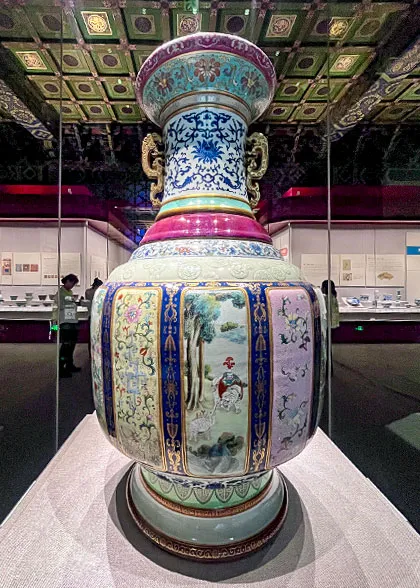 |  | 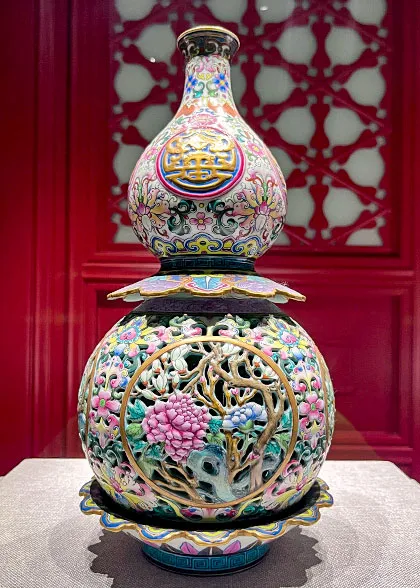 |
| Mother of Porcelain | Pink-Enameled Revolving Vase | Gourd & Flora Rotating Vase |
1. Multi-Colored Large Vase
Known as the “Mother of Porcelain”, it combines almost all the glazes and colors, featuring fifteen layers of decoration. It exemplifies the superb porcelain-making skills of the time and is the only one in existence.
2. Pink-Enameled Hollowed-Out Revolving Vase
This vase features an inner vase depicting four seasons’ scenery that rotates independently within the outer vase.
3. Blue-and-White “Longevity” Character Large Vase
As a birthday gift for Emperor Kangxi (1654~1722), it is famous for the ten thousand neatly written “longevity” characters (寿), symbolizing "boundless longevity".
Theme 10: Lingering Brilliance - Late Qing Dynasty and Republic of China (1796 – 1949 AD)
 |
| Late Qing Porcelain |
Experience the enduring elegance of porcelain crafted during this turbulent time, reflecting the impact of social shifts on traditional artistry.
1. Vase with Dragon Handles, Depicting the Imperial Kiln Factory in Pink Enamel
A panoramic view of Jingdezhen's Imperial Kiln, depicting 61 figures during the porcelain production process.
2. Pale Yellow Bowl with Pink Enamel and Auspicious Patterns
Specially crafted for Empress Dowager Cixi’s birthday banquet, its outer wall features 24 gold “longevity” characters accompanied by red bat patterns symbolizing “good fortune”.
Special Exhibition Area
Room of Bathing Virtue (Yudetang)
 |
| Export Porcelain Adorned with Arabic Script |
From the Tang Dynasty to the Qing Dynasty (618-1911), the story of export porcelain unfolds. Traveling via the Silk Road, these treasures found their way to Asia, Africa, and Europe.
Usually shaped in Western style, they feature both Western oil painting techniques and Chinese meticulous brushwork, boasting decorations that ranged from Chinese flower-and-bird paintings and mythical creature depictions to Western religious scenes and adventurous nautical themes.
East and West Side Halls
 |
| Imperial Wedding Porcelain, Qing Dynasty |
Here, you will find a series of themed exhibitions that showcase the diverse uses of porcelain during Qing Dynasty (1644~1911). The themes are as follows:
Additionally, in the north room of the East Side Hall, there is an exhibition displaying over 1,000 ancient ceramic shards.
 |
| Exhibited Ancient Shards in the Ceramic Gallery |
Tips for Visiting the Ceramic Gallery
1. Please note that the Gallery rotates the exhibits. Although some of the most significant artifacts may not be on display during your visit, you can still marvel at permanent exhibits such as the renowned “Mother of Porcelain”.
2. If you have limited time, prioritize the individual display cases, which typically feature the theme's highlights. Following that, you may proceed to the collective display areas for a comprehensive overview.
3. There is no need for additional tickets or reservations for entering the Ceramic Gallery.
- Last updated on Aug. 01, 2025 by Gabby Li -